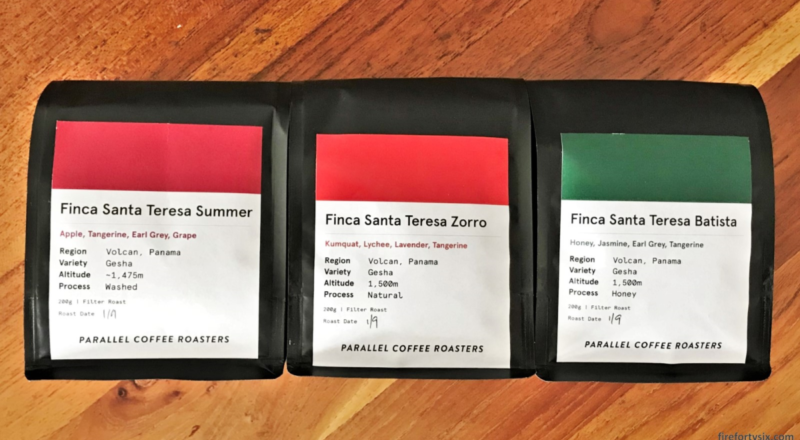During a micro-lot auction held at the Singapore International Coffee Convention in July 2021, the highest bid of US$77 per kilogram was recorded for Gesha beans grown by Finca Santa Teresa in Panama.

Which translates to around S$21 per 200gm just for the cost of coffee greens bought wholesale at an auction.
After you factor in mark-ups for distribution, storage, roasting, packaging and retail, it’s not surprising that a bag of freshly-roasted beans can sell for upwards of S$50 per 250gm.
The Gesha (or Geisha) varietal is famous in the specialty coffee scene, especially for beans grown in Panama. I’ve been curious about how they actually taste but retail prices were too rich for me, coming in at more than 4x the cost of our baseline beans.
I do like nice-tasting coffee, just not at those prices.
But when a flash sale by Parallel Coffee Roasters popped up, offering 50% off on all their freshly-roasted beans, including Geshas from Finca Santa Teresa, I thought about it long and hard for about a minute and pulled the trigger.
Since it was such a compelling discount, I went all the way and ordered three 200gm bags, all from the same farm but processed differently.
Finca Santa Teresa Summer
The first bag I opened was the Finca Santa Teresa Summer, prepared using the washed process. Tasting notes on the bag indicated “apple, tangerine, Earl Grey and grape”.

When I opened the bag and took a whiff, the very first thing that hit me was how incredibly floral the beans smelled. I brought the bag over to The Wife and she was also pleasantly surprised by the aroma.
The intensity increased even further after I ground the beans and took another whiff. Purely based on scent alone, this coffee deserved close to a perfect 10. I was starting to understand why Panama Gesha beans are so highly sought after.
It took slightly more time and effort to grind the harder beans, given that they were roasted lighter than usual, but it was still comfortably under 40 seconds on my trusty 1Zpresso JX-Pro.
After taking a few tries to dial-in the grind, the cup that resulted was light, floral and tea-like. It had a good balance between sweetness and acidity and was one of the more delicate coffees that I’ve had.


To explore a broader range of flavours, I made a subsequent cup by replacing my usual paper filter with a stainless steel one, to allow more oils to pass through.
Theoretically, it should have made a more syrupy cup with increased body, but the effect was minimal, and we still preferred the one using a paper filter.
I also made a cup using a makeshift immersion brewing setup, and while the Earl Grey notes were still noticeable, the flavour was even lighter and didn’t have the full range as the one made using V60 percolation.
Finca Santa Teresa Batista
Since 25gm is our usual daily dosage, the 200gm bag lasted about a week and we moved on to the second one, the honey-processed Finca Santa Teresa Batista with stated notes of “honey, jasmine, Earl Grey and tangerine”.

I used the exact same brew settings and recipe as the first bag, and this time the coffee reminded me of chin chow, a herbal grass-jelly drink that’s commonly sold in Singapore.
And since chin chow is usually drunk cold, I made a Japanese iced coffee for a refreshing drink on a hot afternoon. It tasted like, well, iced chin chow, and while it was still nice, it was too light and wasn’t as flavourful as the hot version.
Having said that, it was the first time I was making Japanese iced coffee and didn’t adjust my grind size. Since I was using less hot water to brew the coffee, I should have ground finer to compensate. Oh well, better luck next time.


Finca Santa Teresa Zorro
The second bag also lasted for a week, and it was time to bust out the Finca Santa Teresa Zorro (“kumquat, lychee, lavender, tangerine”). This was the bag that I was anticipating the most, given that it was processed naturally and should be the fruitiest tasting of the lot.
Like the trailer of an action movie, the first cup I made hinted at the potential excitement to come. It had a prominent berry note, similar to the blueberry explosion of a good Ethiopian coffee, but without the explosion.
The taste was light with a nice lingering aftertaste and had a more complex flavour than the earlier two Geshas, but it lacked body and felt like it was diluted even though I was using my usual 1:16 coffee-to-water ratio.
I reduced the ratio to 1:15 and this time, it didn’t taste diluted anymore. The underlying berriness (is that a word?) shone through, while still retaining its tea-like character. This was definitely our favourite bag among the three that I bought.

Three weeks passed by quickly, and I now understand why Panama Geshas are in such high demand. They are amazingly fragrant and have a delicate floral and fruity taste that could almost be mistaken for a concentrated Earl Grey tea.
But, as The Wife always says, “coffee must taste like coffee!TM“ and by that measure, we probably won’t be buying any again anytime soon, especially given the sky-high (non-discounted) prices. The caveat here is that taste is subjective and YMMV.
Now that I’ve crossed them off my must-try-at-least-once list, next up are Jamaican Blue Mountain and Hawaiian Kona beans, which are, of course, crazy expensive as well and quite hard to find in Singapore.
There is one local roaster that sells them, but I’ve yet to order any beans from them. I’ll start with their usual stuff first, and if they turn out good, then maybe (maybe) I’ll pull the trigger on the good stuff.
